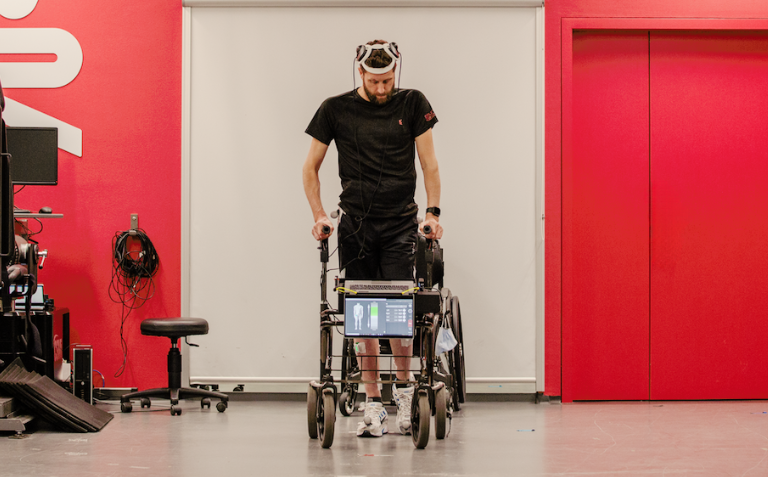
A paraplegic controls his movements with his mind
Share this article
Neuroscientists and neurosurgeons from EPFL/CHUV/UNIL and CEA/CHUGA/UGA report in the journal Nature that they have re-established communication between the brain and the spinal cord with a wireless digital bridge, allowing a paralyzed person to walk again naturally.
“We have developed a wireless digital bridge between the brain and the spinal cord using Brain-Computer Interface (BCI) technology that transforms thought into action,” says Grégoire Courtine, Professor of Neuroscience at EPFL, CHUV and UNIL. Published in the journal Nature, the article “Walking naturally after spinal cord injury using a brain-spine interface” presents the situation of Gert-Jan Oskam, 40, who suffered a spinal cord injury to his cervical vertebrae following a bicycle accident that left him paraplegic. Thanks to the digital bridge, he has regained natural control over the movement of his paralyzed legs, allowing him to stand, walk, and even climb stairs. Gert-Jan explains that he has regained the pleasure of being able to share a beer at a bar with friends: “This simple pleasure represents a major change in my life”.
A digital bridge with two electronic implants: one on the brain, one on the spinal cord
To establish this digital bridge, two types of electronic implants are needed. We have implanted WIMAGINE® devices above the region of the brain that is responsible for leg movements,” explains neurosurgeon Jocelyne Bloch, Professor at the CHUV, UNIL and EPFL. This device developed by the CEA allows us to decode the electrical signals generated by the brain when we think about walking. At the same time, a neurostimulator connected to a field of electrodes was positioned on the region of the spinal cord that controls leg movement.
Guillaume Charvet, head of the BCI program at CEA, adds, “Thanks to algorithms based on adaptive artificial intelligence methods, movement intentions are thus decoded in real time from brain recordings. These intentions are then converted into sequences of electrical stimulation of the spinal cord, which in turn activate the leg muscles to perform the desired movement. This digital bridge operates in wireless mode, allowing the patient to move independently.
With this device, the patient could move his legs a few days after the surgery. He can now stand and walk for about 30 minutes, but the exercise is still tiring.
Recovery of neurological functions in addition to leg movement control
By diligently practicing walking with his digital bridge, Gert-Jan gradually recovered neurological functions that he had lost since his accident. Researchers were able to quantify remarkable improvements in his sensory and motor abilities, even when the digital bridge was deactivated. This digital spinal cord repair suggests that new nerve connections have formed.
At this stage, the digital bridge has only been used to improve the walking of a paraplegic person. Jocelyne Bloch and Grégoire Courtine explain that, in the future, an identical strategy could be used to restore the function of arms and hands. They add that the digital bridge could also be applied to other clinical indications, such as stroke-induced paralysis. ONWARD Medical, in collaboration with EPFL and CEA, has received support from the European Commission through its European Innovation Council to develop a commercial version of the digital bridge with the goal of making the technology available worldwide.
The team is working on a miniaturized version of the device. Clinical trials for the commercial version should begin within 5 years.